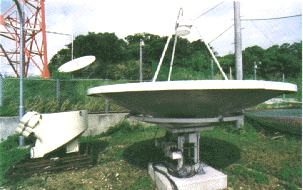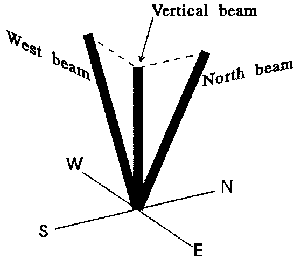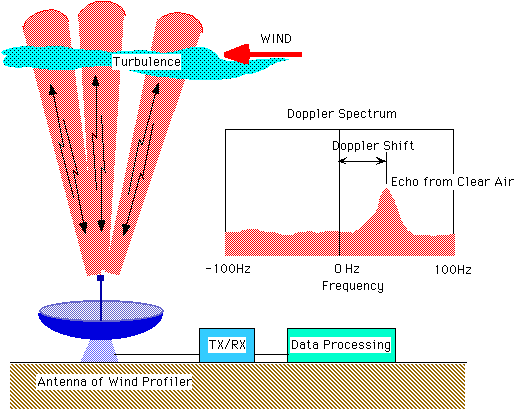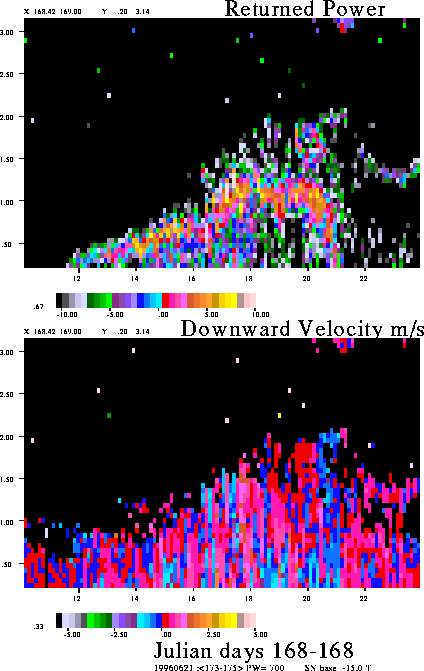Wind profilers
|
B. Geerts |
3/’02 |
|
Fig 1. A 915 MHz wind profiler on Okinawa. (Source: Communications Research Lab, Japan) |
A wind profiler (Fig 1) is a sensitive Doppler radar, designed to point (nearly) vertically and to respond to fluctuations of the refractive index of the (clear) air. The fluctuations of the refractive index are due to turbulence, and turbulence on the scale of half the radar wavelength (Bragg scattering) gives a strong signal. However, the emitted signal is also sensitive to particles such as hydrometeors (rain, snow, hail ...), cloud droplets, and insects. Insects, birds, and airplanes are also possible targets, but their signal can be removed fairly well. The horizontal wind is measured by oblique beams in orthogonal directions (e.g. east and north) (Fig 2). The beams are tilted 15 to 30 degrees from the zenith, and the Doppler shift of the echoes in each direction are compared to determine the wind speed and direction (Fig 3). Just as a Doppler radar (Note 15.A), a wind profiler measures radar reflectivity and radial velocity of its echo, amongst other less important variables. |
||
|
Fig 2. A wind profiler operates three beams, a vertical one (to calculate vertical air motion) and two orthogonal oblique beams (to derive horizontal motion). (Source: Norman Donaldson, Environment Canada) |
Fig 3. Schematic of the operation of a wind profiler. (Source: CRL Japan) |
||
|
Wind profilers operate in various frequencies. The 915 MHz (33 cm, UHF) profiler (Fig 1) measures the wind at low levels, typically up to 1-3 km above ground level, depending on atmospheric conditions, especially humidity. The top of the PBL (the entrainment zone) is very visible because the large humidity and temperature gradient there cause a large change in index of refraction (Fig 4). The 915 MHz profiler has fairly small antennas (at most 3x3 m), making it transportable and less expensive. Therefore it is widely used in field experiments (1). Other wind profilers operate at other frequencies. A VHF wind profiler (50 MHz or 6 m) measures wind profiles between 2 and 16, occasionally 20 km AGL, but the antenna occupies 2 soccer fields (100x100m). An example is the Middle/Upper (MU) radar in Shiga, Japan. The US National Oceanographic and Atmospheric Administration (NOAA) operates a network of 400 MHz wind profilers. These are smaller (antenna size about 10 x10 m), and measure the winds up to the tropopause. The higher the frequency, the smaller the antenna, the smaller the turbulent flow scale that is resolved, the higher the resolution close to the radar, but the higher the attenuation. Therefore 915 MHz profilers provide accurate measurements near the ground (above about 100 m), but they can only see up to 1-3 km AGL. More details about wind profilers can be found on a web site by Norman Donaldson, who also maintains a compendium of wind profiler sites world-wide.
Fig 4 (right). 915 Mhz wind profiler measurement of the development of the PBL during a sunny day in June 1996 near Montreal (2). The upper image shows returned power, a measure of echo intensity. The vertical scale is height (0-3 km) and the horizontal dimension is time (hours GMT, local solar time is about GMT-4.5). The lower image is vertical air motion in m/s, in the same time-height section. Red is downward and blue upward. (Source: Norman Donaldson, Environment Canada) |
|
||
References
(1) Angevine, W.M., A.W. Grimsdell, L.M. Hartten and A.C. Delany 1998. The Flatland boundary layer experiments. Bull. Amer. Meteor. Soc., 79, 419-31.
(2) Mailhot J., J.W.Strapp, J.I. MacPherson, R. Benoit, N.R. Donaldson, F. Froude, M. Benjamin, I. Zawadski, and R.R. Roger, 1998: The Montreal-96 Experiment on Regional Mixing and Ozone (MERMOZ): An overview and some preliminary results. Bull. Amer. Meteor. Soc.,79, 433-442.



